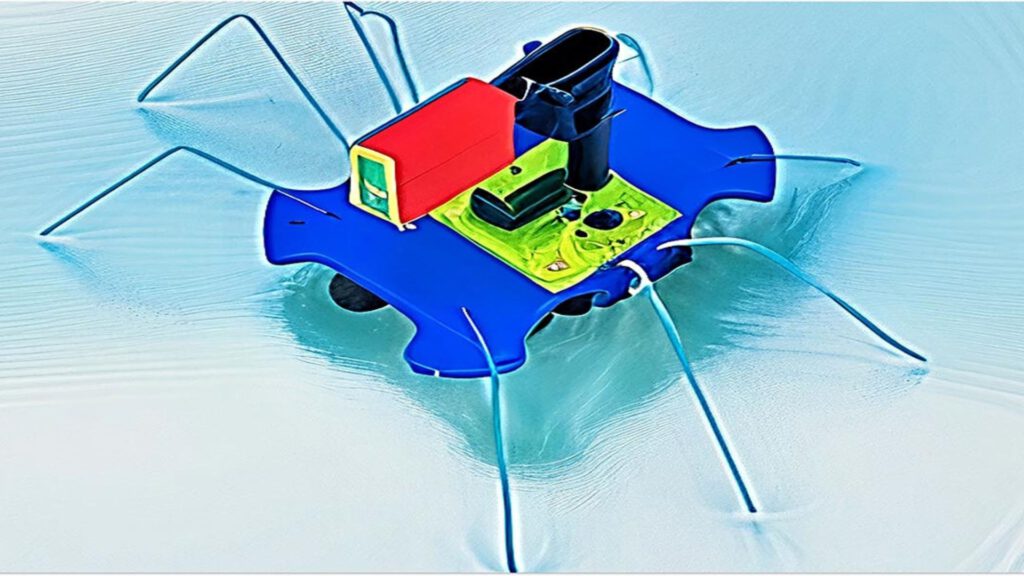First developing bead-like drones, and now self-propelled “bug” robots, scientists are making great strides in the field of innovation.
Researchers at Binghamton University, State University of New York, have designed a tiny, bug-like robot to explore the marine Internet of Things (IoT) in an effort to transform ocean monitoring.
Inspired by biological digestion, an advanced machine with a self-sustaining energy system has been designed.
Ocean of Things’ small underwater robot
Futurists predict that by 2035, more than one trillion autonomous devices will be integrated into every aspect of human life as part of the Internet of Things (IoT).
Regardless of size, most objects have the potential to collect and transmit data to a central database without human intervention.
Because water makes up most of the Earth (an estimated 332 million cubic miles, or 71%), such underwater robots could help understand vast environments, including the oceans, which contain 96.5% of the water on Earth.
To this end, the US Defense Advanced Research Projects Agency (DARPA) has launched a program called “Ocean of Things.”
The insect glides across the water’s surface using a bacteria-powered biobattery.
In their study, the researchers explained that the insects utilise microbial fuel cell (MFC) technology to convert organic matter in the aquatic environment into electricity through catalytic redox reactions.
“To extend the lifespan of the MFC, spore-forming Bacillus subtilis is used as an anode biocatalyst, leveraging its ability to withstand harsh conditions and reactivate in a favorable environment, thereby extending the lifespan of the MFC,” the study noted.
Longer retention time with Janus interface
The bugs can survive autonomously thanks to the Janus interface, which powers the underwater robot with a steady supply of the organic substrate the microbes need to survive.
The researchers further explained that a biomimetic Janus membrane with asymmetric surface wettability was incorporated, enabling selective substrate uptake.
It extracts nutrients from the water to fuel the production of bacterial spores within the underwater robot. The biobattery will likely have a shelf life of 100 years.
“When the environment is favorable for the bacteria, they become vegetative cells and generate electricity,” said Professor Seok-hoon “Shawn” Choi of Binghamton University.
“But if conditions are unfavourable – for example, if it’s very cold or there are lack of nutrients – they will revert to spores, which allows them to extend their operational life.”
The BugBot resembles a small insect adapted to life on still water and is powered by a motor that enables it to walk through the water.
The researchers added that the motor is powered by microbial metabolism fueled by organic nutrients through the Janus membrane.
“This work demonstrates the feasibility of harnessing natural processes for technological advances and sets a new standard in the design of autonomous systems,” the authors say.
The researchers plan to soon test the bacteria on the underwater robot to determine which ones are most effective at producing energy in stressful marine environments.
“We used very common bacterial cells, but more research is needed to know what actually lives in that area of the ocean,” Choi said in a university statement.
“Previously we have demonstrated that combining multiple bacterial cells can improve sustainability and power. This is another idea. Using machine learning, we may be able to find the optimal combination of bacterial species that improves power density and sustainability.”
This research was published in the academic journal Advanced Materials Technologies on June 22, 2024.
Newsletter
Blueprint Daily
Get the latest news in engineering, technology, space and science with The Blueprint.
About the Editor
Shubhangi Dua As an eccentric and imaginative multimedia journalist with a Masters in Magazine Journalism, I am constantly coming up with fresh ideas and finding innovative ways to tell a story. I have dabbled in various media fields, from holding the pen as a writer to capturing moments as a photographer and even strategizing on social media. With a creative mind and attention to detail, I have worked in the dynamic field of multimedia journalism and written on sports, lifestyle, arts, culture, health and wellbeing for Further Magazine, Alt.Cardiff and The Hindu. I am on a mission to create a media landscape that is as diverse as a Spotify playlist. From India to Wales and now England, my journey has been full of adventures that inspire me to paint, cook and write.

